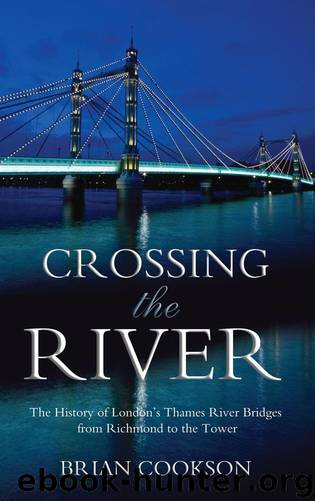Crossing the River: The History of London's Thames River Bridges From Richmond to the Tower by Brian Cookson

Author:Brian Cookson [Cookson, Brian]
Language: eng
Format: epub
Tags: Non-Fiction, Travel, Europe, Great Britain, History, England, London, Bridge
ISBN: 9781780578392
Google: xEQXAQAAMAAJ
Amazon: B00Z8NCV4M
Barnesnoble: B00Z8NCV4M
Goodreads: 25732754
Publisher: Mainstream
Published: 2006-05-31T23:00:00+00:00
The 1962 centenary was equally lacklustre. As reported in The Times of 25 May 1962, the only celebrations consisted of a lunch at County Hall, presided over by the chairman of the LCC, and the application of a new coat of battleship-grey paint, which was the standard colour of all of London’s Thames bridges in the post-war period. In 1970, the bridge was repainted in the present green colour to match the colour scheme of the House of Commons.
After the construction of County Hall in 1922, Westminster Bridge provided a link over the Thames between the home of the national government and that of London’s government, until the abolition of the GLC in 1986. At either end of the bridge are sited two distinctive sculptures. On the County Hall side stands a 13-ton lion made in 1837 of Coade stone. Coade stone is an artificial stone made of terracotta mixed with ground quartz and glass to make it extremely long-lasting and waterproof. The firm which made it was located on the site of County Hall until it closed down in 1840. The so-called Coade Lion was originally painted red and stood over the entrance arch of the Red Lion Brewery, which was located by Hungerford Bridge near today’s Festival Hall. The brewery was demolished in 1949, but the lion reappeared at the Festival of Britain in 1951. When the festival closed, the lion was saved by the personal intervention of George VI, and it was moved to Waterloo Station. In 1966, when Waterloo Station was redeveloped, it was decided to re-erect the lion on the empty pedestal by County Hall. Its present colour is white, although the real colour of Coade stone is tawny yellow. Unseen to the public is a small room underneath where security guards can make themselves a cup of tea.
The bronze sculptural group on the opposite side of the bridge is of Queen Boudicca with her two bare-breasted daughters, driving a scythed chariot in full battle cry. The sculptor was Sir Hamo Thorneycroft, who specialised in heroic sculptures of famous Britons. His statue of Oliver Cromwell stands near by outside Westminster Hall. Strictly speaking, Boudicca should be driving her chariot through the City rather than through Westminster, since it was there that she slaughtered the Romans before her final defeat and death at their hands. This happened long before Westminster was founded. An amusing letter appeared in The Times of 25 August 1964 concerning a court case in which a young woman was charged with indecency for wearing a topless dress on Westminster Bridge. The writer pointed out that: ‘The Magistrate failed to take account of two other women in topless dresses seen hanging about on the north bank of the bridge for some little time now in a chariot driven by their mother.’
Westminster Bridge’s Coade stone lion
Download
This site does not store any files on its server. We only index and link to content provided by other sites. Please contact the content providers to delete copyright contents if any and email us, we'll remove relevant links or contents immediately.
Asking the Right Questions: A Guide to Critical Thinking by M. Neil Browne & Stuart M. Keeley(5595)
Autoboyography by Christina Lauren(5170)
Eat That Frog! by Brian Tracy(4403)
Dialogue by Robert McKee(4291)
Sticky Fingers by Joe Hagan(4080)
Journeys Out of the Body by Robert Monroe(3552)
Annapurna by Maurice Herzog(3408)
Full Circle by Michael Palin(3362)
Schaum's Quick Guide to Writing Great Short Stories by Margaret Lucke(3294)
Elements of Style 2017 by Richard De A'Morelli(3292)
The Art of Dramatic Writing: Its Basis in the Creative Interpretation of Human Motives by Egri Lajos(2977)
The Diviners by Libba Bray(2862)
Why I Write by George Orwell(2861)
In Patagonia by Bruce Chatwin(2852)
The Mental Game of Writing: How to Overcome Obstacles, Stay Creative and Productive, and Free Your Mind for Success by James Scott Bell(2830)
The Fight by Norman Mailer(2822)
Atlas Obscura by Joshua Foer(2801)
Venice by Jan Morris(2505)
The Elements of Style by William Strunk and E. B. White(2428)
